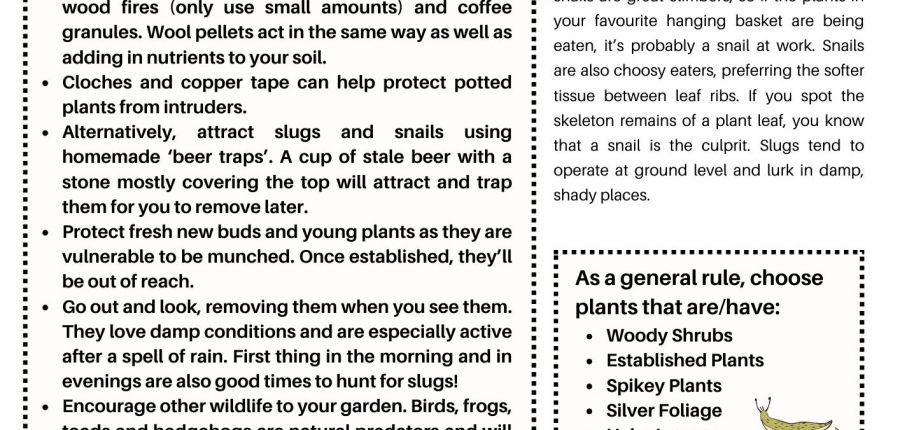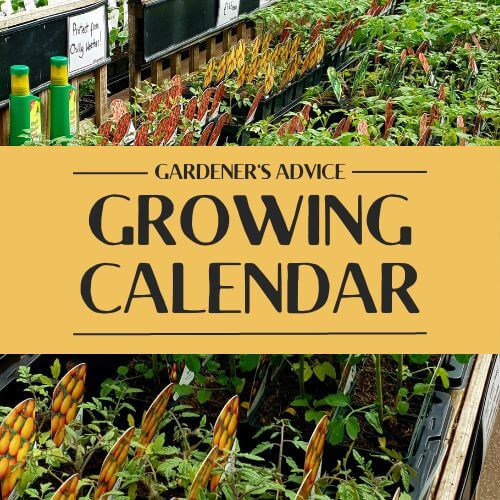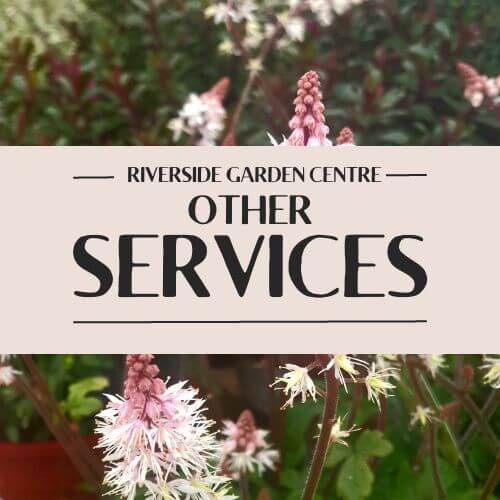Slug & Snail Resistant Plants
Posted By: Category: Pests and Diseases.jpg)
.jpg)
Download this guide as a pdf or pick on up from Riverside!
Slugs and snails are the bane of the gardener’s life. The tell-tale signs are slimy trails across the surface of the soil and holes eaten in leaves. If conditions are right, slugs and snails can demolish a whole plant in a very short time. Both are ‘opportunists’ and will eat what they can reach, but there are some plant they tend to favour less, have developed their own resistance or can cope with occasional damage.
Slug or Snail?
Does it matter? Both are a nuisance to keen gardeners! You can tell the difference by checking the type of damage caused and where it occurs. Both leave slimy trails, but snails are great climbers, so if the plants in your favourite hanging basket are being eaten, it’s probably a snail at work. Snails are also choosy eaters, preferring the softer tissue between leaf ribs. If you spot the skeleton remains of a plant leaf, you know that a snail is the culprit. Slugs tend to operate at ground level and lurk in damp, shady places.
TOP TIPS
- Mulch Mulch Mulch! The best thing is using mulch, gravel and bark around your plants as slugs and snails can’t move on the dry surfaces. They also will avoid crossing scattered eggshells, straw, ash from wood fires (only use small amounts) and coffee granules. Wool pellets act in the same way as well as adding in nutrients to your soil.
- Cloches and copper tape can help protect potted plants from intruders.
- Alternatively, attract slugs and snails using homemade ‘beer traps’. A cup of stale beer with a stone mostly covering the top will attract and trap them for you to remove later.
- Protect fresh new buds and young plants as they are vulnerable to be munched. Once established, they’ll be out of reach.
- Go out and look, removing them when you see them. They love damp conditions and are especially active after a spell of rain. First thing in the morning and in evenings are also good times to hunt for slugs!
- Encourage other wildlife to your garden. Birds, frogs, toads and hedgehogs are natural predators and will benefit the biodiversity in your garden.
As a general rule, choose plants that are/have:
- Woody Shrubs
- Established Plants
- Spikey Plants
- Silver Foliage
- Hairy Leaves
- Aromatic Leaves
- Hardy
Vegetables
Slugs love vegetables - especially tasty young plants! Try the following which seem not to attract slugs as much as others:
- Winter brassicas: Kale, Sprouts, Cauliflower, Spring Cabbage
- Potatoes: Pentland Dell, Pentland Ivory, Pentland Squire, Pentland Falcon, Desiree
Herbs - Mediterranean herbs are off the menu for slugs and snails!
- Chives
- Hyssop
- Lavender
- Malgovam
- Mint
- Oregano
- Rosemary
- Sage
- Thyme (all)
- Woodruff
Bedding
- Alysumm
- Argyranthemums
- Begonias
- Cathranthus
- Gazanias
- Geraniums/Pelagonium*
- Impatiens
- Lantana
- Marigolds (French and English)
- Nemesia
- Pentas
- Sweet Peas
And everything else....
- Acanthus mollis (Bear’s Breeches)
- Achillea filipendulina (Yarrow)
- Alpine Strawberry
- Agapanthus - hybrids and cultivars (African Lilly)
- Alchemillia mollis (Lady’s Mantle) *
- Anemone hupehensis and A.x hybrid *
- Antirrhinum majus (Snapdragon)
- Aquilegia species (Columbine) *
- Armenia species (Thrift)
- Aster amellus, A.x frikartiiand, A. novae-anliae (Michaelmas Daisy)
- Astilbe x arendsii *
- Aubrieta
- Bergenia (Elephant’s Ears)
- Brunnera
- Campanula
- Centaura dealbata and C. montana (Cornflower)
- Corydalis lutea
- Cynara cardunculus (Cardoon)
- Cyclamen (perennial)
- Dicentra spectabilis (Bleeding Heart) *
- Digitalis purpurea (Foxglove)
- Erigerons (Fleabane)
- Eryngium species (Sea Holly) *
- Euphorbia species (Spurge) *
- Foeniculum vulgare (Fennel) *
- Fuchsia cultivars *
- Gaura (Beeblossom)
- Gaillardia aristata (Blanket Flower)
- Geranium (perrenial)
- Geum chiloense (Avens)
- Helenium (Sneezeweeds)
- Hellebore
- Hemerocallis cultivars (Day Lily) *
- Heuchera
- Knautia
- Lamium (Dead-nettles)
- Leucanthemum
- Liatris spicata (Gay Feather)
- Lychnis
- Lysimachia punctate (Loosetrife)
- Myostis species (Forget-Me-Not)
- Nasturtium
- Phlox paniculata (Garden Phlox)
- Ornamental grasses and sedges *
- Penstemon (Beardtongues)
- Physostegia virginiana (Obedient Plant)
- Polemonium foliosissimum (Jacob’s Ladder)
- Polygonum species (Knotweed)
- Potentilla hybrids and cultivars (Cinquefoil)
- Pulmonaria species (Lungwort) *
- Rheum (Ornamental Rhubarb)
- Rodgersia
- Rudbeckia fulgida (Cone Flower)
- Salvia greggii (Autumn Sage)
- Salvia x superba (Sage)
- Saxifraga x urbium (London Pride)
- Scabiosa caucasica (Scabious)
- Sedum spectabile (Ice Plant)
- Sempervivum species (House Leek) *
- Sisyrinchium species (Pigroot)
- Solidago species (Golden Rod)
- Stachys macrantha (Lamb’s Ears or Big Betony) *
- Tanacetum coccineum (Pyrethrum)
- Thalictrum aquilegiifloium (Columbine Meadow Rue)
- Tiarella (Foamflower)
- Tradescantia virginiana (Spiderwort)
- Tropaeolum species (Nasturtium) *
- Verbascum species (Mullein)
- Verbena (Rigida or Bonariensis)
- and all grasses too!
*self-seeding plants







